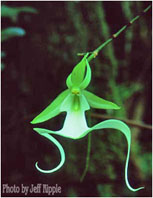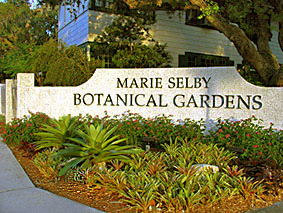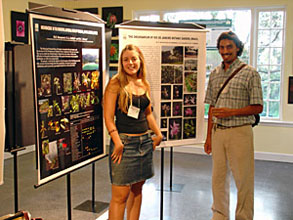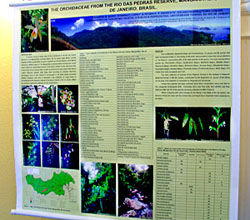

 |
 |
 |
The International Orchid Conservation Congress II “IOCC II”
was held at the Marie Selby Botanical Gardens, in Sarasota, Florida, USA, on May
16-21, 2004. In the whole, we were a total of 115 participants, more than half
was formed by Americans, followed by the Australians, Latin-Americans, Europeans,
Asiatics and one African registrant. Brazil was well represented: among 17 Latin-Americans
present, 7 were Brazilian, being 5 from Rio de Janeiro city and 2 from the state
of São
Paulo.
The program was divided in workshops before and after the Congress, oral presentation and posters, field trips, meetings of the Orchid Specialist Group and a forum of discussion about CITES. |
|
The
presentations were formed by themes: specific threats for the orchids, integrate
experiences for conservation, environmental education, studies of conservation
cases, mycorrhiza fungus, studies of the population and its regeneration.
As Conservation was the main theme, some of the richest ecosystems in orchids and the most threatened constituted, sometimes, the center of the discussions. Our Atlantic Rainforest, Ecuador, Peru, Colombia, Panama and Madagascar were subject of different lectures. The Atlantic Rainforest, as a matter of fact, was focus of interest since the first day of the congress. The ecologist Dr. Stuart Pimm, expert in birds’ bio-diversity, was invited to give the inaugural lecture and asked the audience if we knew where the biggest diversity in orchids is. He believes that there is where we should concentrate our efforts to conservation. In Dr. Pimm's opinion, based on the bio-diversity of the birds, the ecosystem more important to be preserved in the Americas, is the low altitude Atlantic Rainforest of Rio de Janeiro State. In the same morning, Dr. Richard (Dick) Warren, David Miller's partner in Macaé de Cima, RJ, brought the Atlantic Rainforest again to the center of the attention. Dick showed the results of the orchids survey they are doing in “Serra dos Órgãos” and emphasized the deficit of orchids species found on the anticline of the mountain (side turn to the interior of the continent) which has been used for agriculture and cattle raising for centuries. |
Besides,
the posters presented by Melissa Bocayuva (The Orchidaceae family in the Municipal
Ecological Park of Prainha, Rio de Janeiro), Pedro Constantino (Strategies of
Conserving Laelia lobata), Eduardo Saddi (A Survey of the Orchids from the Reserve
of Rio das Pedras, Mangaratiba, RJ) and Carlo Alberto Zaldini, M. Bocayuva and |
 |
 |
|
E.
Saddi (Orchids from the Park of Marapendi, Rio de Janeiro) drew the attention
to other aspects of our rich flora and the necessity of preserving it. I
had the opportunity to participate of workshops about Mycorrhiza Propagation and
Propagation of Terrestrial Orchids both concerning difficult techniques, but not
very sophisticated, of germination of orchids in cultivation media where mycorrhiza
is growing. It means a bigger success in the reintroduction of orchids in natural
environments. |
|
||